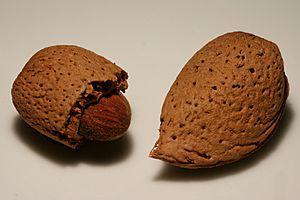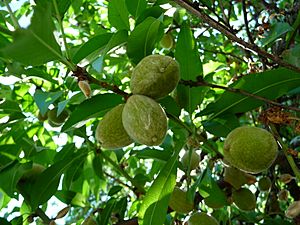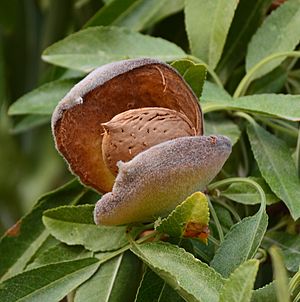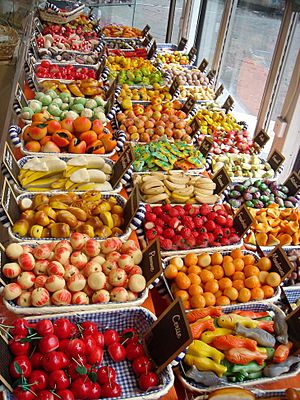Almond facts for kids
Quick facts for kids Almond |
|
|---|---|
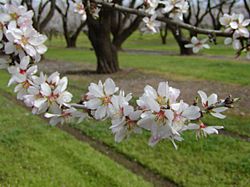 |
|
| Almond flowers | |
| Scientific classification | |
| Kingdom: | |
| Division: | |
| Class: | |
| Order: | |
| Family: | |
| Subfamily: | |
| Genus: | |
| Species: |
P. dulcis
|
| Binomial name | |
| Prunus dulcis |
|
The almond (Prunus dulcis) is a type of tree that comes from the Middle East, India, and North Africa. The word "almond" also refers to the tasty, edible seed that grows on this tree. Many people around the world enjoy eating almonds.
This tree first grew in the Middle East and is mentioned many times in old books like the Bible. It is a very important plant in some cultures.
The fruit of the almond tree is called a drupe. It has an outer hull, a hard shell, and inside is the seed we call an almond. Even though we often call it a nut, it's actually a seed!
When you "shell" almonds, you are taking off the hard outer shell to get to the seed. Almonds are sold both with and without their shells. If you see "blanched" almonds, it means they have been soaked in hot water. This makes their thin, brown skin (called the seedcoat) easy to remove.
Almond oil is great for your skin, making it soft and smooth. Massage therapists often use it during massages. This oil can also be used to help certain musical instruments, like oboes and clarinets, stay in good condition.
Contents
What an Almond Tree Looks Like

The almond tree is a deciduous tree, which means it loses its leaves every autumn. It can grow to be about 4 to 10 meters (13 to 33 feet) tall. Its trunk can be up to 30 centimeters (12 inches) wide. The leaves are usually 3 to 5 inches long.
In early spring, before the leaves appear, the tree grows beautiful white or light pink flowers. Almond trees grow best in places with a Mediterranean climate. This means they like warm, dry summers and mild, wet winters. The best temperature for them to grow is between 15 and 30 degrees Celsius (59 and 86 degrees Fahrenheit).
Almond trees start producing a good amount of fruit to sell about three years after they are planted. They reach their fullest fruit production five to six years after planting. The fruit becomes ready to pick in the autumn, about 7 to 8 months after the flowers bloom.
The almond fruit is about 3.5 to 6 centimeters (1.4 to 2.4 inches) long. Botanically, it's not a nut but a drupe. Other drupes include plums and cherries, which have a soft, fleshy outer part. But the almond's outer part, called the hull, is thick, leathery, and grey-green with a fuzzy feel.
Inside the hull is a hard, woody shell. This shell is like the pit of a peach. Inside this shell is the edible seed, which we commonly call an almond. Usually, there is one seed, but sometimes you might find two.
Where Almonds Come From
Almonds originally grew in the Mediterranean climate region of the Middle East. They were found as far east as the Yamuna River in India. Over time, people carried almonds to other places. They spread along the Mediterranean coast into northern Africa and southern Europe. More recently, they were brought to other parts of the world, especially California in the United States.
In the wild, many almond types are toxic (poisonous). But ancient people learned to choose and grow the sweet types. This was the start of growing almonds for food. We don't know exactly which wild almond plant led to the sweet almonds we eat today.
Domesticated almonds (the ones we grow and eat) have been found from the Bronze Age (around 3000–2000 BC). A famous example is the almonds found in Tutankhamun's tomb in Egypt, which are from around 1325 BC. Today, almonds are grown in many European countries. Germany is one of the northernmost places where they are grown, but the domesticated form can even be found as far north as Iceland.
How Almonds Are Grown
In California, growing almonds requires a lot of help from bees. The pollination of California's almonds is the biggest planned pollination event in the world each year. Almost one million beehives (nearly half of all beehives in the US) are brought by truck to the almond farms in February. The bees help the almond trees make fruit.
To help almond farmers, scientists have created new types of almond trees that can pollinate themselves. This means they don't need as many bees. However, almond trees can still face problems from insects, fungi, viruses, and bacteria.
In 2013, the world produced about 2.9 million tonnes (which is 2.9 billion kilograms) of almonds. The United States was the biggest producer, growing 1.8 million tonnes.
In the United States, most almonds come from California. Almonds are California's third most important farm product. The US is the main supplier of almonds to the world. Most almonds are sold without their shells (70%), while the rest are sold with shells or are processed into other products.
Australia is the largest almond growing area in the Southern Hemisphere. It is the second largest almond producing country overall. Most almond farms in Australia are located along the Murray River in New South Wales, Victoria, and South Australia.
Spain is also a major almond producer and has many different types of almonds grown there.
How We Use Almonds in Food
Almonds are often eaten by themselves, either raw or toasted. But they are also used in many different dishes. You can buy almonds in many forms: whole, sliced (like flakes or slivers), or as flour. Almonds can also be pressed to make almond oil, or blended to make almond butter or almond milk. These products are used in both sweet and savory foods.
Almonds are often sprinkled over breakfast foods like muesli and on desserts, especially ice cream. They are a key ingredient in marzipan, nougat, and many pastries, cookies, and other sweets.
Almond butter is a spread similar to peanut butter. It's popular with people who have peanut allergies and is known for its naturally sweeter taste. Almond flour (ground almonds) mixed with sugar or honey makes marzipan. This is often used as a gluten-free option instead of wheat flour in baking.
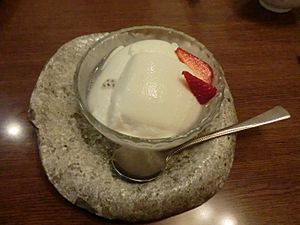
The young, developing fruit of the almond tree can be eaten whole. These are called "green almonds." They are still green and soft on the outside, and their inner shell has not yet hardened. Green almonds are a bit sour, but they are a popular snack in parts of the Middle East. People often dip them in salt to balance the sour taste. In the Middle East, almonds are also often eaten with dates.
Sometimes, almonds can cause an allergy or food intolerance in some people.
Images for kids
-
Persian miniature showing the almond harvest at Qand-i Badam, Fergana Valley (16th century)
-
Almond tree with blossoming flowers, Valley of Elah, Israel
See also
 In Spanish: Almendro para niños
In Spanish: Almendro para niños


